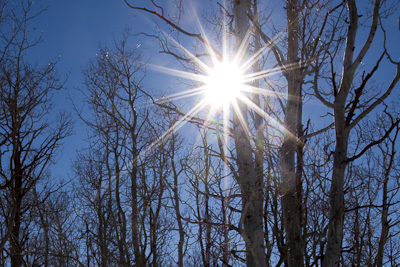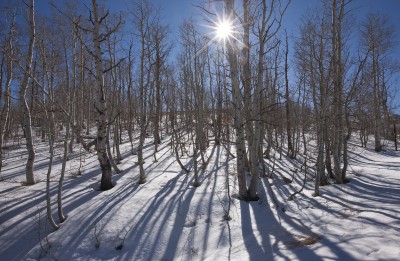One of the stranger and more interesting artifacts you’re likely to come across in photographing nature is the sunstar. You’ve probably seen the effect, or one like it, where bright points of light. While many of these effects are the result of ::amazon(“B00004ZCDV”, “specialized star filters”)::, effects like this are, in some situations, easy to create without a filter due to a strange quirk in the physics of light, the phenomena of diffraction. Fortunately, you don’t need a degree in physics to get sunstars in your own photos, just a few simple tips.
There are just two primary elements to any sunstar, a bright point of light, and a very tiny (and not perfectly round) lens aperture.
First, there’s the matter of the light source. While it can be any light source that is much brighter than it’s surroundings, typically the sun or a bright electric light in a night scene. Even the sun, which is about a half-degree in diameter, is really too broad a light source for the best sunstar effect. You can get stronger effects such as the image shown here by blocking most of the sun with another object, letting only a sliver of the sun’s light into the camera, such as the angle formed by a couple branches in this image. Looking into the sun, you could first be very careful to protect your eyes by not looking through the viewfinder (an electronic viewfinder is useful here). As you’re pointing your camera into the sun, you’ll also want to be careful to minimize other forms of lens flare (and the image here has a few bad bits of it), be sure your optics are clean and that you remove any unnecessary filters before shooting.
Second, there’s the matter of the aperture. Diffraction happens when light passes very very close to an object, such as the edge of the lens aperture, the smaller the lens aperture (that is, the higher the f-number), when the aperture is large, most of the light coming into the camera is relatively far from the edge of the aperture, but as you stop down more and more, a larger and larger fraction of the light coming through the lens passes very close to the lens iris. So, to get a sunstar, you’ll want to stop down to the smallest aperture you have available to you, this sample shot was taken at f/22, if I’d had f/32 on the lens I was shooting with, I would have used that instead. The number of points in the star is related to the number of segments that make up the lens aperture, this fourteen-point star is the result of a seven blade aperture. (An even number of blades will create the same number of points in a sunstar, and odd number of blades will create a sunstar with twice as many points as blades.)
That’s it! Get as thin a sliver of sunlight as you can, stop down as far as you can, and enjoy!


David
24 Nov 2010Hi Joe, you say “remove any unnecessary filters before shooting”. Would I need to remove my UV filter also?
Thanks
Joe Decker
28 Jan 2011@David: You won’t need to, but if you don’t, you may see more lens flare–either more of those standard “lens flare” artifacts in your image, or veiling flare/veining glare, where you just get an otherwise inexplicable loss of contrast.
The sunstar will still happen whether you remove the filter or not but removing the filter may give you a cleaner image.
Cindy Weaver
2 Jan 2013I have been trying and trying to get this effect in my photos. So now I will try again and hopefully I will get a good sunstar, thank you,
Cindy